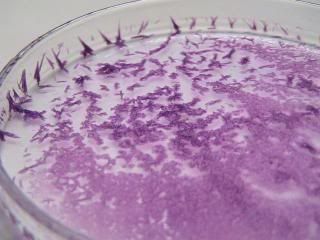Quote: Originally posted by woelen  | Reading this thread raised some concerns in me:
http://www.sciencemadness.org/talk/viewthread.php?tid=1778
It is about exotic primaries, based on transition metal ammine and ethylenediamine complexes with oxidizing anions as counterions. Most of the
compounds, described in this thread, are peroxodisulfates. What concerns me is the instability on storage of some of the compounds. Some compounds
decompose overnight (e.g. the ethylenediamine complex of copper with peroxodisulfate as counterion), others ignite after some time, especially when
put in sunlight.
I always had the impression that perchlorates were quite stable (the ion is quite inert at room temperature), but after reading this thread I am
concerned a little bit. I have a small vial of the nickel complex and a somewhat bigger vial of the copper complex. Could it be that the stuff ignites
or explodes one bad day in the (near) future, simply by storing it at room temperature? I hardly can imagine that this can happen, but if someone over
here with some authority can elaborate on that, then that would be very nice and hopefully can take away my concerns. I do not want unstable,
potentially self-igniting or self-exploding stuff around.
Maybe PHILOU Zrealone can comment on this?
|
Of course I can comment on this 
You have to take in account:
1°)the inherent stability or explosive properties of the couple amine-anion....
For example NH4NO3 is stabler than NH4ClO4 what are safer than N2H5NO3 itself safer than N2H5ClO4...
Primary amines are stabler than ammonia itself stabler than hydrazine...but where are NH2-OH, R-O-NH2, R-NHOH, R-NH-NH2, R2-N-NH2, R-NH-NH-R', ... to
be placed?
Perchlorates are by definition more heat and shock sensitive than nitrates...and perchlorates are safer than chlorates... but what to say about
persulfates, iodates, bromates, periodates, perbromates, nitroformates, tetranitroethandiates,...
2°)the heat of combustion and oxygen balance.
3°)I wouldn't trust peroxydes or peroxoanions especially when sticking to metallic core...what are known to be uncompatible.
4°)the oxydability of the amine or the power/sensitivity of the oxydant...it is an oxydoredox couple...as such it wants to be in its stablest
form...decomposed
5°)the oxydoredox potential of the metalic cation
6°)the metallic core may induce a catalytic effect or a photosensitivity....
N2H5NO3 or N2H5ClO4 are relatively hard to detonate even in contact with the flame of a match, they simply burn... but Ni(N2H4)3(NO3)2 almost D2D
transits while Ni(N2H4)3(ClO4)2 is reputed to detonate in water solution...
Long time ago I had an unexpected detonation of N2H5NO3 in a galvanized pipe due to contact with the metallic copper of the detonator.
Obviously the traces of HNO3 in the N2H5NO3 eather reacted with Cu to generate Cu(2+) and NxOy or dissolved traces of CuO and Cu(OH)2 generating
Cu(2+); then Cu(2+) and NxOy were in contact with the N2H4.HNO3 leading to decomposition of the hydrazine, formation of the unstable Cu(N2H4)2(NO3)2
and overheating!
By chance no person was armed, only material damages!
I worked with Ruthernium (III) with tris (diamino) complexes for my end study work and they where light sensitive. |








 Nice work woelen!
Nice work woelen!








 .
.














 . I noticed that in the cold, the perchlorates are remarkably stable. When heated in a flame, however, they burn quickly or even
deflagrate, if the cationic species contains organic parts. So, perchlorate is a nice alley in the quest for easily separated and purified complexes,
but its use requires some care.
. I noticed that in the cold, the perchlorates are remarkably stable. When heated in a flame, however, they burn quickly or even
deflagrate, if the cationic species contains organic parts. So, perchlorate is a nice alley in the quest for easily separated and purified complexes,
but its use requires some care.